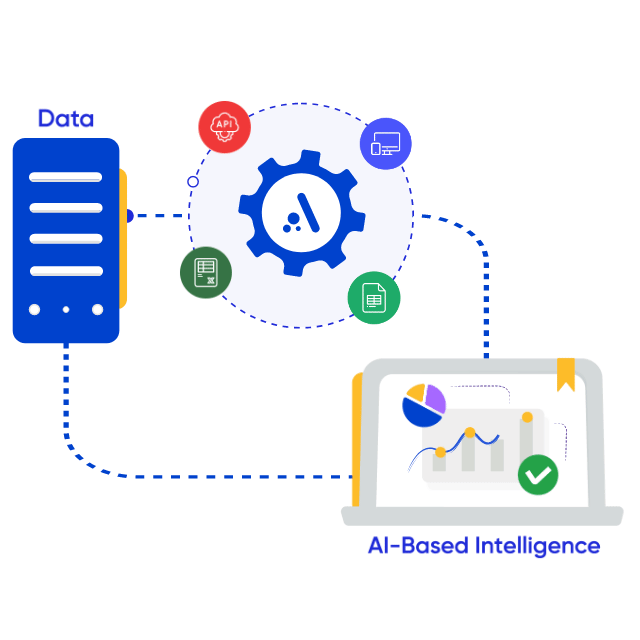How to best communicate the results of your data collection to stakeholders?

Data Collection
Data collection is a systematic process of gathering observations or measurements. Whether you are performing research for business, governmental or academic purposes, data collection allows you to gain first-hand knowledge and original insights into your research problem.
While methods and aims may differ between fields, the overall process of data collection remains largely the same. Before you begin collecting data, you need to consider:
- The aim of the research
- The type of data that you will collect
- The methods and procedures you will use to collect, store, and process the data
To collect high-quality data that is relevant to your purposes, follow these four steps.
How to effectively communicate the results of the employee engagement report? (with examples)
You did a survey on employee engagement, perfect!
You are already measuring your staff’s commitment to your mission, the team, and their role within the company.
But what are you going to do with the results you get from their contributions?
And most importantly, how will you move from reporting on employee engagement to meeting your staff’s desires for professional growth?
Are you still struggling to find the answers?
Our guide is for you. We have put together practical tips and examples that will allow you to:
- Know exactly what to do with employee engagement survey data.
- Make sense of what that data reveals.
- Excellence in communicating engagement survey results.
The importance of employee engagement for companies
First things first: the relevance and impact of an employee engagement report goes beyond the borders of HR. Of course, measuring engagement is a People Ops function. And it’s also one of the trends in employee engagement: actively listening to determine whether workers are thriving.
But a survey report on employee engagement transcends concerns about team members’ aspirations. It’s a tool full of insightful information that C-suite executives need to understand how healthy and robust their workforce is.
And that is a strategic question. Because there is no way to drive business results without engaged and enthusiastic staff.
Employee engagement drives productivity, performance, and a positive workplace.
How to analyze your employee engagement data
Let’s consider that you already know how to design an employee engagement survey and set your goals.
Therefore, now we will focus on analyzing the results obtained when carrying out the study.
The first important tip is to prepare the analysis in advance. To do this, put in place the mechanisms to quantify and segment the data.
Use numerical scales, scores and percentages
Use numerical scales and convert responses to numerical values whenever you can in your engagement survey.
You will see that comparing the data will not cause you a big headache.
This is because numbers are much less prone to misinterpretation than the opinion of your staff in free text.
Consider qualitative contributions
Although quantitative data is objective, qualitative data must also be analyzed. Because, sometimes, it is not easy to put thoughts and feelings into figures. And without data, it would be impossible to draw conclusions about employee motivation, attitudes, and challenges.
For example, if you ask people to rate their satisfaction with their team from 1 to 5, a number other than five won’t tell you much. But if you ask them to write down the reason for their incomplete satisfaction, you’ll get the gist of their complaint or concern.
Segment the groups of respondents
Without a doubt, your workers are divided into different groups according to different criteria. And that translates into different perceptions of their jobs, their colleagues and their organization.
To find out, segment the engagement survey results while keeping the responses anonymous.
Assure your employees of their anonymity and ask them to indicate their:
- age;
- gender;
- department and team;
- tenure;
- whether they are junior, intermediate or senior;
- your executive level (manager, director, vice president or C-level).
Read the consensus
In this step the real action of the analysis begins.
If you’ve followed our recommendations for quantifying (and segmenting) survey data, you’ll be ready to determine precisely what they’re trying to tell you.
In general terms, if most or all of your staff express the same opinion on an issue, you need to investigate the issue and improve something.
On the other hand, if only a few people are unhappy with the same issue, it may not be necessary to address it so thoroughly.
It all depends on the importance of the topic for the business and the proper functioning of the team and the company. And it’s up to stakeholders to decide whether it’s worth putting effort into finding out what’s behind the results.
Cross data
Engagement levels are not always related to staff’s position, teams or your company. Instead, those levels may have to do with other factors, such as salary or benefits package, to name a couple.
And it’s up to you to combine engagement survey data with data from other sources.
Therefore, consider the information in your HR management system when reviewing the results of your engagement.
Additionally, evaluate engagement data against business information.
This is information that you can extract from your ERP system that is closely related to business results.

Compare results
The ultimate goal of analyzing engagement survey data is to uncover critical areas for improvement. And to do this as comprehensively as possible, you should compare your current engagement survey results with
- The results of your previous engagement surveys to understand the engagement levels of your organization, departments and teams over time.
- The results of national and global surveys on engagement, especially those of other companies in your sector with a similar activity to yours.
And these are the perceptions to look for:
- Why is your organization performing better or worse than before?
- Why do certain departments and teams perform better or worse than before?
- Why does your company perform better or worse than similar ones in your country or abroad?
How to organize data in your employee engagement report
An employee engagement survey report should shed light on how engagement affects the performance of your company and your staff.
But a report like this is useless if you do not organize the data it contains well. Let’s see how.
First of all, you must keep in mind the objective of the survey. That is developing an action plan to improve the areas with the greatest positive impact on your employee engagement levels.
So keep in mind that traditionally some areas score low in any organization. We’re talking pay and benefits, career progression , and workplace politics, to name a few.
But as a general rule, you should prioritize areas where your company scored poorly compared to industry benchmarks. Those are the ones most likely:
- Generate positive ROI once you improve them.
- Promote improvement of all other areas of the employee experience .
Typically, the most impactful areas are:
- Appreciation to employees;
- Response to proactive employees;
- Employee participation in decision making;
- Communication with leaders.
But it might suggest other areas to focus on.
Now, you need to conveniently organize the survey results in your employee engagement report.
In other words, you must disclose the commitment figures:
- for the entire company;
- by department;
- by team;
- by age and sex;
- by possession;
- by executive level;
- by seniority;
- by period (current month, quarter or year versus the previous one);
- by region (within your country, in your foreign locations and in comparison to national and global benchmarks in your sector);
- any combination of the above that makes sense, such as by gender and team or by age and department.
And to identify areas for improvement, you should display the survey data by those areas within each of the divisions above. We recommend that you convert these divisions into distinct sections of the document.
We also recommend using media to visualize results, such as charts and graphs.
For example, use:
- Bar charts: to identify trends over time.
- Line graphs: to compare this year’s data with last year’s data.
- Callout Charts: To highlight surprising figures or conclusions.
These visuals will help stakeholders objectively understand and analyze the results of the employee engagement report. But most importantly, visualization makes it easy to prioritize areas for improvement and provides actionable results.
Good practices for communicating engagement survey results
After collecting and analyzing employee engagement survey data, it’s time to share it within the company.
And here are our tips for communicating engagement survey results to your employees and leaders.
3 Tips for Sharing Employee Engagement Survey Results with Employees
Immediately after completing the employee engagement survey, the CEO should make a communication to the entire company. Alternatively, the VP of HR or a senior HR leader can do this.
And in that communication, they make a recognition.
Thank employees for participating in the study
Your boss – if not yourself – can do this via email or in an all-hands meeting.
But it’s essential that you thank employees as soon as the survey closes. And in addition to saying thank you, the leader must reaffirm his commitment to take engagement to higher levels.
Advise them to appreciate employees’ dedication to helping improve your organizational culture. This will convey the message that employee opinion is valuable, which in itself has a positive impact on engagement.
Briefly present the commitment data you have obtained
One week after closing the survey, your leader should share an overview of the results with the organization. Again, an email or company-wide meeting is all it takes.
The summary should include participation statistics and a summary of the main results (best and worst figures).
This time is also a great opportunity for your leader to explain what employees should expect next. And one way to set expectations is to outline the action plan.
However, their leader cannot provide many details at this time.
The first communication of employee engagement results should focus on numbers with a broader impact.
In other words, it is an occasion to focus on the effect of data at the organizational level.

Report complete engagement data and plan improvements
Three weeks after the survey closes, HR and leaders – team leaders and other executives – must get to work:
- Carefully review the results.
- Detail the action plan: the areas of improvement you will address and the engagement initiatives you will implement.
Once key stakeholders have decided on the action plan, it’s time to communicate all the details to employees.
The deadline should be no later than one or two months after the survey closes.
3 Tips for Sharing Engagement Survey Results with Leaders and Key Stakeholders
Once the results of the engagement survey are obtained, the first step is to share them with the management team. These are our main recommendations on how to approach this task.
There is no need to rush when deciding what to do with the data.
Give your leaders time to review the engagement data, digest it, and think carefully about it.
We recommend this calendar:
- One week after the survey closes, before communicating high-level results.
- Three weeks after completing the survey, before we begin to thoroughly discuss the data and delve into the action plan.
- One or two months after the survey closes, before communicating detailed results.
Increasing the engagement levels of your employees is a process of change. And as with any corporate change, internalizing it does not happen overnight. Additionally, your leaders are the ones who must steer the helm of change, so they need time to prepare.
Emphasize the end goal and fuel the dialogue
The process of scrutinizing engagement data starts with you. Introduce your leaders:
- the overall employee engagement score;
- company-wide trends;
- department-specific trends;
- strengths and weaknesses (or opportunities).
Leaders must clearly understand what organizational culture is being pursued.
And the survey results will help them figure out what’s missing.
So make sure you communicate this mindset to them.
Next, as you discuss the data in depth, you should promote an open dialogue. Only then will your leaders agree on an effective action plan to increase engagement levels.
Don’t sweep problems under the rug
You can’t increase employee engagement without transparency. And you play a role in it too.
You should share the fantastic results and painful numbers from your engagement survey with your leaders.
Reporting alarming discoveries is mandatory for improvement.
After all, how could you improve something without fully understanding and dissecting it?
Additionally, investigating negative ratings and comments is ultimately a win-win for both workers and the company.
Real Examples of Employee Engagement Reports
Here are four employee engagement reports that caught our attention. We’ll investigate why they did it and what you can learn from them.
1. New Mexico Department of Environment
The New Mexico Department of Environment’s engagement report :
1. Start with a message from a senior leader in your organization, providing:
- The overall response rate;
- The overall level of commitment;
- Some areas for improvement;
- A reaffirmation of senior management’s commitment to addressing employee feedback.
2. Use graphs to highlight the most interesting conclusions.
3. Breaks down the figures from an overview to year-on-year highs and lows by department and survey section .
4. Compare your employees’ level of engagement to a national benchmark.
5. Includes information on the organization’s commitment actions throughout the year prior to the survey.
6. Demographic breakdown of respondents .
7. Clarify next steps for your leaders and how employees can participate.
8. Discloses an appendix containing year-over-year scores for all survey questions that used a numerical scale.
Note: The year-over-year comparison allows this organization to identify trends in employee engagement.
2. GitLab
The GitLab Commit Report :
- Explain how survey responses will be kept confidential .
- List the areas of interest for the survey.
- Shows a chronology of the actions that the company carried out around the survey.
- Clarify the steps that will follow after closing the survey.
- It presents the global response rate, the global commitment level and an industry benchmark.
- Thank you employees for participating in the survey.
- It reveals the top-ranked responses in the three main areas of interest and compares them to the industry benchmark.
- Highlight areas that require improvement.
👀 Note: The calendar with the survey actions may seem insignificant. However, it is an element of transparency that generates trust among readers of the report.
3. UCI Irvine Human Resources
The University of California HR Employee Engagement Report :
- Start by justifying why employee engagement is important to workplace culture and various stakeholders.
- Defines the responsibilities of everyone involved in engaging those stakeholders.
- Remember the results of the previous employee engagement survey and set them as a reference .
- Compare the most recent survey results with the baseline figures.
- Distinguishes engaged, disengaged, and actively disengaged staff members between previous and most recent data by organizational unit.
- Lists new opportunities that the department should address and strengths that it should continue to explore.
- It presents a timeline of the phased engagement program and some planned actions.
- Describes the next steps leaders should take with their team members.
👀 Note: The report notes that the figures vary between the two editions of the survey because the HR department encouraged staff participation instead of forcing it.
4. UCI Riverside Chancellor’s Office
The University of California, Riverside Office of the Chancellor’s Employee Engagement Report :
- Contains instructions on how scores were calculated .
- Compare employee engagement survey results to different types of references , from previous survey results to national numbers.
- Highlights issues that represent a priority for the organization.
- Distinguish the level of statistical significance that each number has , clarifying the extent to which they are significant.
- Describe the suggested actions in some detail.
- It groups scores by category – such as professional development or performance management -, role – such as manager or director -, gender, ethnicity, seniority and salary range.
- Break down the scores within each category.
- Shows the total percentage of employees at each engagement level , from highly engaged, empowered and energized to disengaged.
- It concludes with the main drivers of commitment , such as the promotion of social well-being.
Note: The document is very visual and relies on colors to present data. While this appeals to most readers, it makes it less inclusive and compromises organization-wide interpretation.
Now that you know how to analyze your survey data and organize your engagement report, learn how to create an employee engagement program .





























